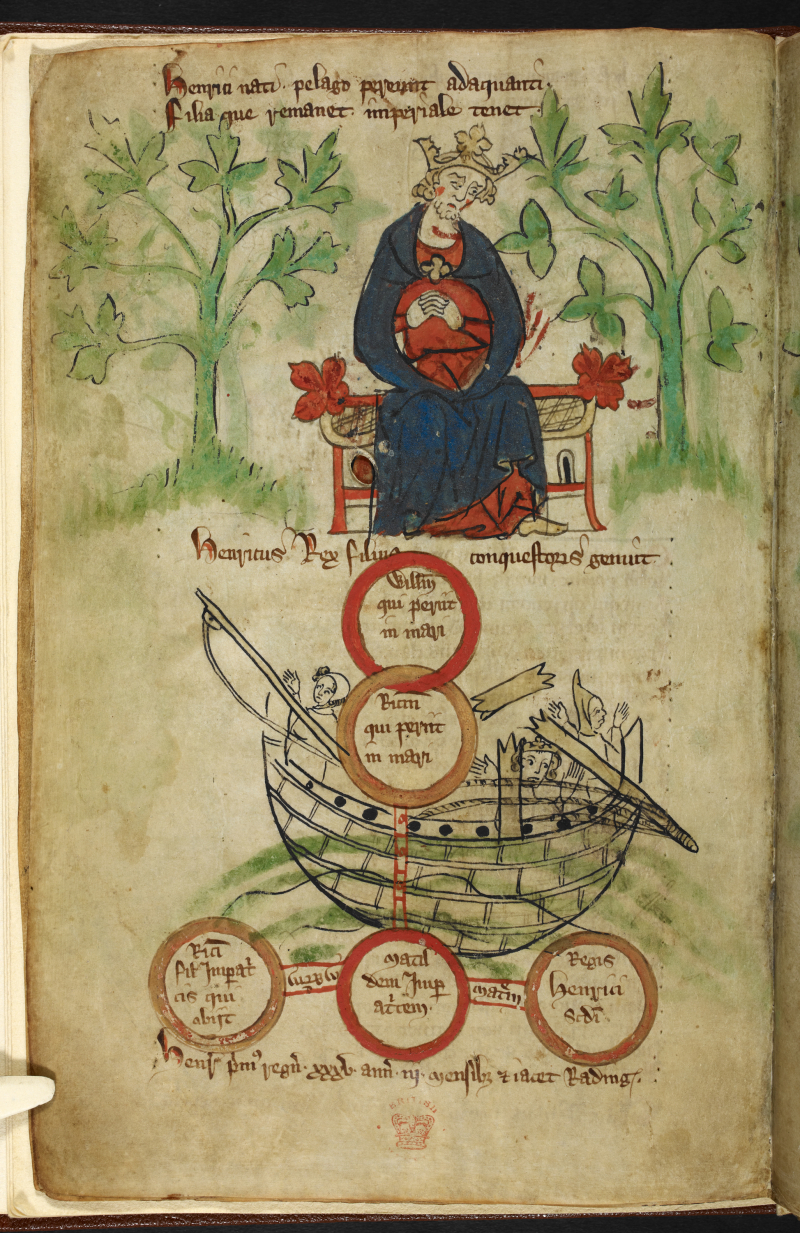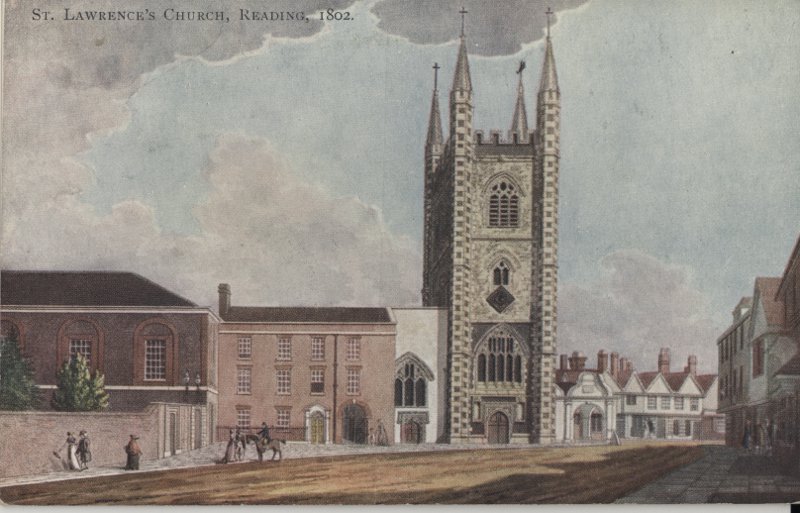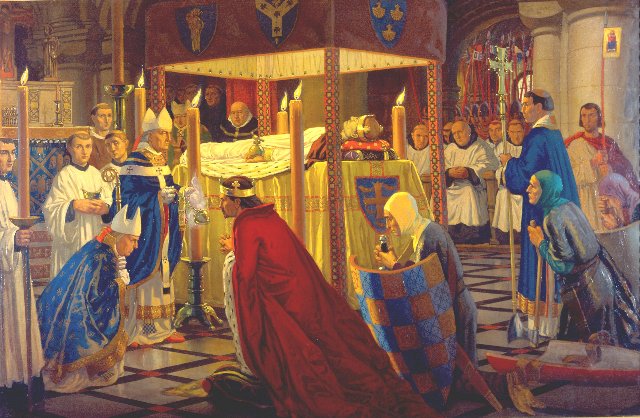In 2021, we celebrated the 900th anniversary of the foundation of Reading Abbey by King Henry I on 18 June 1121.
Henry I was the youngest son of William I (William the Conqueror), whose invasion of England in 1066 is chronicled by Reading’s full-sized version of the Bayeux Tapestry.
Henry’s great royal abbey – a religious community centred around a magnificent church – was one of the largest monasteries in Europe. The abbey had a large and impressive church, where dozens of monks would worship, and living quarters in which they resided. No expense was spared in the abbey's construction, and stone was imported from Normandy and the Cotswolds. Today, Reading Abbey Quarter covers the large former precinct of this royal monastery.
Why did Henry build Reading Abbey?
A contemporary chronicler alive at the time of the abbey's foundation, William of Malmesbury (c. 1090 - c. 1143), gave a striking account of the care with which Henry I, founder of Reading Abbey, prepared his only legitimate son, William, for future greatness. He notes that Henry had spent no less than four years arranging William’s future when, in the winter of 1120, disaster struck. Prince William and his companions (including his half-siblings Richard and Matilda) died at sea. Their ship, sailing from Normandy to England, struck rocks at Barlfeur harbour. This is known as the White Ship Disaster.

Illustration of King Henry I and the White Ship from Peter of Langtoft’s Chronicle: Royal MS 20 A II, f. 6v
No chronicler made a direct connection between this disaster and Henry’s decision to found Reading Abbey. However, John of Worcester made it very clear that, at least in his view, Henry’s relationship with God and the Church was in need of major improvement.
It was certainly agreed that Henry not only founded Reading Abbey, but also made it rich and prestigious, as befitted the place in which he intended to be buried. The date of the foundation is given in the ‘Annals of Reading’ as 18 June 1121, and the scale of the grants given by the king is shown by the confirmation charter of 1125. This was copied into the abbey’s charter-collections (which were known as cartularies).

The charter in Reading Cartulary: BL Egerton Ms 3031, f13r
A royal abbey
The status of the abbey is made clear by the king’s repeated statements of the royal rights and powers which he is granting. Two reasons for the foundation of the new abbey are given. The first is that it should benefit the souls of Henry himself and all his close relatives. The second is that it should support and provide for pilgrims, the poor, and visitors. This made Reading Abbey distinctive from the start.
The importance of the abbey is also reflected in the lands it was granted all over England. Whilst there were mostly in Berkshire, the abbey received property in Herefordshire, Warwickshire, Leicestershire, Bedfordshire, Oxfordshire, Sussex, and Kent. The abbey also had a priory on the Isle of May in the North Sea, off the east coast of Scotland.
The abbey was built on a site on the eastern edge of Reading, on high ground between the River Kennet and River Thames. These were used to transport stone during the building work, whilst the major roads leading to Reading made the abbey accessible both for visiting pilgrims and to Henry as he travelled his kingdom.
Reading Abbey was set up with the help of monks from Cluny Abbey in France. Many members of Henry’s family had made gifts to Cluny Abbey, or founded Cluniac monasteries of their own, so for the king this was a natural choice. In its first two years, Reading Abbey was run by Prior Peter and seven monks from Cluny Abbey. Others came from the Cluniac monastery at Lewes, Sussex. Peter returned to Cluny in 1123, and was replaced by Hugh, prior of the Cluniac monastery in Lewes. Hugh was a widely respected scholar and gave Henry’s foundation even greater status.
Soon after its establishment, steps were taken to ensure the abbey’s commitment to charity did not clash with other aspects of its life. By as soon as 1135, a hospital (the Hospital of St Mary Magdalene) had been founded, with a chaplain who cared for twelve lepers. Around fifty years later, another hospital was founded: the Hospital of St John the Baptist. This was linked to the church of St Laurence (which is still in Reading today). It supplied accommodation, food and clothes to thirteen inhabitants and poor travellers. The latter would thus be kept apart from the visitors received in the abbey’s main guest house.

St Laurence's Church stands tall on this postcard from 1802: REDMG : 1981.41.9
The death of Henry I
Henry died before his Abbey was complete, and he was buried here in 1136 in front of the high altar. Reading remains his resting place today.

King Henry I, the youngest son of William the Conqueror, was interred at Reading Abbey in 1136. Oil on canvas by Harry Morley, 1916: REDMG : 1931.280.1
The royals in Reading
Immediately after the king's death, the abbey and the ground nearby became a desirable location for other royals and nobles to be buried. Adeliza, Henry I’s second queen, died in 1151 and was buried in the abbey church to the side of the king’s burial place. William, the oldest son of Henry II and Eleanor of Aquitaine, died in 1156 at the age of 2 or 3 years and was buried ‘at the feet’ of Henry I in the abbey church. Reginald, Earl of Cornwall (an illegitimate son of Henry I) was buried in the same part of the church in 1175, adding to the number of royal funerals and impressive tombs. By this time, the abbey church had been solemnly dedicated by Archbishop Thomas Becket, in 1164. Building work was still ongoing during this ceremony, attended by King Henry II (grandson of Henry I) and his followers. When the church was completed, the abbey church stood as the fourth-longest church in England.
Later, Eleanor of Aquitaine’s patronage of Fontevraud Abbey created a rival mausoleum for the Plantagenets. Eleanor, Henry II, and their son Richard were all buried at Fontevraud, and the tombs that still survive today give an idea of the splendour of such burials.

Henry II and Eleanor of Aquitaine are among many royals buried at the Church of Fontrevraud. Photo credit: Adam Bishop, CC BY-SA 3.0
Relics and miracles at the abbey
Many religious relics were given to Reading's abbey, including the hand of the apostle St James. This arrived in our town through Henry I’s daughter, Empress Matilda, who was married to the Holy Roman Emperor, Henry V. When the emperor died in 1125, Matilda returned to England and brought the hand with her.
This relic possessed powerful healing properties, performing miracle cures throughout the twelfth century. Learn more in our blogpost about the abbey's relics and their veneration.
Other important relics included parts of the body and blood of St Laurence and the coals on which he is said to have been roasted alive. King John gave the abbey another prized relic: the head of St Philip. These relics attracted pilgrims believing that praying in the presence of a saint’s relics could work miracles. Stories of successful cures were written down and repeated far and wide to spread the reputation of the abbey’s top relic and attract more pilgrims.
King John, and beyond
During the reign of King John, Reading played an important part in the warfare between the king and his rebellious barons. John’s advisers borrowed books on law and theories of justice from the abbey. The king even resided in the abbey in 1215 during the negotiations which led to the issuing of Magna Carta. In 1216 Reading provided a base from which John faced an army led by Prince Louis of France, who was in control of London and Windsor.
The next peak of royal visits and burials came in the reign of King Henry III, who stayed frequently at Reading. Both his brother, Earl Richard of Cornwall, and two of Richard’s children were buried at Reading. Henry III celebrated Easter at Reading six times, and Ascension Day four times. On each occasion, the king held formal court in the abbey.
Catering for royal visits involved having a special store of wine as well as supplies of fish and game. Preparations included plans for the performance of special chants, and the king travelled with his own priests and even his own books and vessels for mass. Even so, the arrival of the king, members of his family, barons and followers, each with servants and equipment, would have meant a considerable increase in the populations of both the abbey and the town. The court needed to be entertained, catered for and looked after.
This is where the Reading Abbey manuscripts come in.
The Reading Abbey manuscripts
The most famous Reading Abbey manuscript, kept today in the British Library, is known as British Library MS Harley 978 (hereafter Harley 978). This manuscript, and its surprising and illuminating range of contents, will be the focus of this online exhibition.
The Reading Abbey manuscript displays the work of skilled scribes and illuminators and was clearly expensive to produce. Learn about how Harley 978 was produced.
Harley 978 opens with a section on the performance and teaching of fashionable music, including the famous round, Sumer is Icumen In. Discover the significance of this song and its connection to Reading.
The manuscript then goes on to techniques for timing healthcare (especially bloodletting) to harmonise with the solar and lunar calendars. Explore magic and medicine in Harley 978.
Both music and the calendar were matters on which monks were expected to be expert, but other parts of this complex manuscript are more surprising – perhaps especially the inclusion of a poem celebrating the victory of Simon de Montfort over King Henry III at the Battle of Lewes in 1264.
Harley 978 also contains an impressive collection of the ‘Lays’ and ‘Fables’ of one of the most famous women writers of the medieval period, Marie de France, whose patrons included members of the royal family and court. Delve into the work of Marie de France in Harley 978.
One section contains an extensive collection of satirical poems, of a sort usually associated with university students. The authors of these poems called themselves followers of ‘Golias’ and praised a life of love and leisure – but did so in learned Latin verse! If these poems were aimed at students visiting Reading then other literary sections of the manuscript seem to have had an older, more aristocratic audience in mind.
Harley 978 thus provides materials to entertain, challenge, educate and care for secular visitors to the abbey, and suggests the many ways in which the monastic community would interact with those of high status – whilst also providing hospitality and charity for pilgrims and the poor.
For more information on other manuscripts from Reading Abbey, visit our Reading Abbey manuscripts blogpost.
Top image credit: Chronicle of Matthew Paris (1236-1259), from BL MS Cotton Claudius D. vi, f.9.





